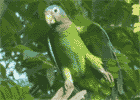|
Can you identify this bald head? Roll your mouse over the image. |
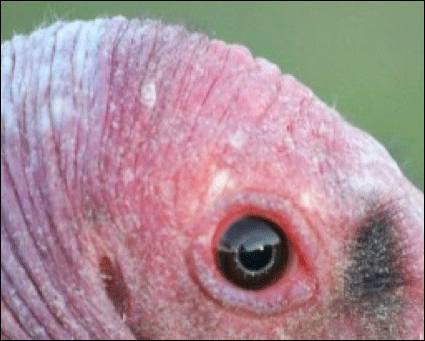
|
July - December 2015
This character took its time to form, rather like a big pot of cornmeal porridge releasing the occasional gassy “blurp”. Mostly, the slowness was due to my grappling with whether the field observations needed to be carried to their logical conclusion.
Our story begins in July, when Mr. Mike’s eyes sparkled even more than when be bought his “new” Series III Land Rover. This time, they twinkled with the arrival of his DJI Phantom Series 3 unmanned aerial vehicle quadcopter (from here on, more lovingly referred to as his faithful drone). His joy was palpable, tempered only by the fact that, as users of an iPad v1 and a Nokia handheld which was cutting edge in 2002, we didn’t have a tablet to actually control the drone.
Nonetheless, he happily twisted on the little propeller blades, sat for hours parked next to the Sherwood Content basketball court so he could watch countless youtube videos on how he eventually would be able to operate his faithful drone (remember, we don’t have reliable internet signal in Windsor, so big downloads always require an expedition), and he made plans for where he would chuck the lithium ion batteries should they expand and explode from overheating – a worryingly common issue on drone chat groups.
Then joy oh joy, the tablet arrived, software was updated, lithium ion batteries charged . . . "bee dee dee deep," the green lights twinkled like peeny wallies (aka Click Beetles, aka Elateridae) indicating “all systems communicating”. And the man who worked on Concorde, lectured for AirBus in Toulouse, and developed the entire maintenance training programme for Air Jamaica (i.e., if you need an AirBus overhauled, bring it to Mr. Mike . . . then again, scratch that idea - presumably you'd want it put back together in your lifetime). Anyway, he was all set to take his faithful 2 kg drone on her maiden flight. Fortunately, a Japanese film crew had used one here in 2014, so we knew what to expect, especially that annoying whining noise . . . which we quickly learned to love because, gosh, when you lose visual contact with your faithful drone and you start sweating over whether the “return to home” command is going to fail . . . nothing is more reassuring than hearing that damn irritating whining, whir!
| The world through the eyes of UAVs and Turkey Vultures. NOTE: Audio of nestling and adult Turkey Vultures was added to the video. |
Of course, students in the Western Hemisphere are taught in school that vultures have a keen sense of smell for rotting flesh. And Mr. Mike does get a little nervous about his drone not returning home. But I wouldn’t say he gets so sweaty-stinky that the Turkey Vultures confuse him for food. And he does bathe regularly.
To test the “Stinky Mr. Mike” hypothesis, I took the drone up for a spin over the yard:
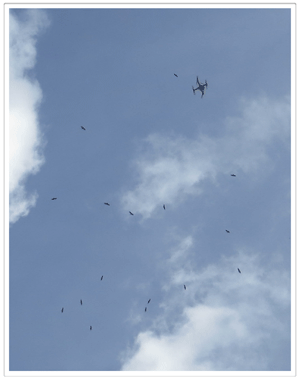
And there they were, within 45 seconds of the drone reaching its pre-determined height, 3 or 4 Turkey Vultures starting to circle overhead, always above the drone, never dropping below it. During one of the most magnificent “kettle assemblages”, 30 vultures came to investigate. Clearly, the scent of decaying flesh isn’t the only thing to which they pay attention in their environment. So, time to see what the literature says.
Fortunately for us, our good friend Dr. Gary Graves has as keen affection for vultures as they have for rotting carcasses. Gary and his colleagues were curious about the differences between Turkey Vultures and Black Vultures (Coragyps atratus). As Gary says, Turkey Vultures have an exquisite sense of smell. Indeed, they can detect the scent of decomposing flesh in concentrations as small as a few parts per billion in the air. Investing in such a highly-tuned sensory system can be metabolically expensive, so it’s not unusual for other senses to regress. For example, humans have pretty good daytime visual acuity but our sense of smell is lousy when compared to a dog, which is equally unimpressive at visually detecting somthing at a distance unless it moves. Our new chief of security, GorgonZella (aka Zella, not "stinky cheesehead", tho' her father is a Danish Blue), is 10,000 - 100,000 times better at detecting smells than I am: where I could detect the smell of a cube of sugar in a cup of coffee, she could detect that same amount of sugar in the equivalent of two Olympic-sized swimming pools filled with water. Of course, we all smell the foul, worse-than-dead-rat stench of the rotting coconuts she brings to her bed, ick. Interestingly, Jamaican Turkey Vultures also enjoy picking at old, rotting, split-open coconuts which they find on the ground.
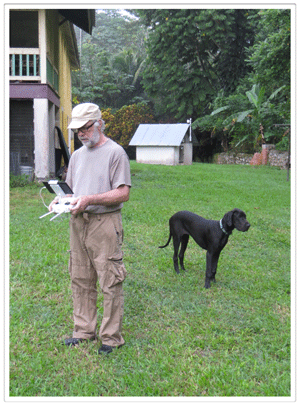
|
|
| Mike focused on keeping his drone from crashing, Security Chief Zella focused on protecting him from rogue coconuts. |
Gary and his colleagues wondered “if you can smell your way to a food source do you really need to have super-good eyesight?”. To explore the question, they compared Turkey Vulture eye morphology to that of Black Vultures, a species which doesn’t have a keen sense of smell but has very acute vision to spot a road-kill deer or beached fish while it (the vulture) soars at up to 300 meters above ground. Black Vultures also can be sneaky: if they see soaring Turkey Vultures starting to make smaller circles and then descend, the Black Vultures will use these cues to then try and beat the Turkey Vultures to the food. Turkey Vultures will only beat the Black Vultures if the dead carcass is hidden from direct view, say under a forest canopy. But don’t worry for the Turkey Vultures, they too have a sneaky counter-strategy: they are able to soar just above the canopy, staying aloft by taking advantage of small scale turbulence that occurs when horizontal air currents hit the edges of trees of variable heights. This enables Turkey Vultures to stay low and avoid communicating visual cues to Black Vultures – literally, staying below enemy radar.
Do Vultures Read the Literature?
In a word, No. To the surprise of Gary and his colleagues, the photoreceptor cells – the cells on the retina which determine the quality of one’s visual acuity – were as densely packed on Turkey Vultures as they were on Black Vultures. Looking at all the physical evidence, they concluded that both species of vultures have equivalent and very good vision.
So, it seems that our Windsor Turkey Vultures are pretty clever to pay attention to Mr. Mike’s faithful drone. When in a hovering, holding pattern over the yard, it rather mimics the behaviour of a vulture which has gotten the first whiff of something dead.
Feeling quite guilty that we were causing the Turkey Vultures to waste energy coming to investigate what the “weird, 4-winged hovering bird” had discovered and only to see (sniff ?) a healthy Mr. Mike in the yard; curious to see how long it took them to detect a dead carcass; and wanting to make amends for the drone, after dispatching the most-recent rat trapped in our bedroom, I placed the carcass in the yard for casual observation (but I’m not crazy, I made sure I could watch it while sitting comfortably on the sofa). About 27 hours later, the first Turkey Vultures soared over the house. Over the course of two hours, 5 perched in the trees overhanging the peripheral wall – a volt of vultures had assembled. They showed general interest in the ground and equal interest in preening each other. Alas, it then started to rain . . . and rain . . . and rain all afternoon. So the vultures missed out on their free rat-snack because by the following morning, it was well-past its shelf life – even vultures have standards! The gassy blurps of the rat had peaked – phew!
I wondered a bit about their caution at dropping to the ground. Was the rat too small for them to see amongst the grass blades? My friend Brian says that Turkey Vultures are champions at sniffing out dead rats, lizards, and bits of bird under leaf litter, so size wasn’t likely to be the issue – and it was certainly . . . umm. . . odiferous. I was relieved to learn this information from Brian because, finding a larger carcass . . . say, sacrificing Mr. Mike in the name of my curiosity . . . well, that seemed a bit extreme.
Was the maniac scampering of 6-month-old chief of security an issue? I’d kept Zella-pup restricted to the other end of the yard, mostly because I didn’t want her pinching the carcass and presenting it to me with great pride during dinner. But that doesn’t mean that the vultures didn’t already have a “mental image” of this potential predator bouncing around the yard. Afterall, vultures are extremely vulnerable when they’re on the ground – they don’t have the muscular power for strong take-off flight or strong sustained flapping – so caution in making the final approach to the ground is warranted. To test the Zella effect, I put the next rat carcass on the 3-meter tall stone ruins (sorry visitors, December was a “good” month for rat research). But something else pinched the carcass before the Turkey Vultures detected it. And, then, alas (ha ha, never thought I’d utter that!) I appear to have trapped-out all the rats, so I need a new source of decaying flesh. Mr. Mike continues to be quite useful around the house . . . so I guess I have to put my curiosity on-hold.
| Attractive Heads from Around the World Can you identify these magnificent birds? Roll your mouse over the image to learn its name. | ||
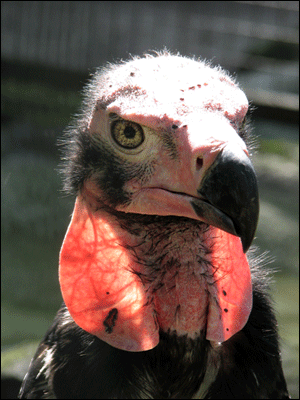 |
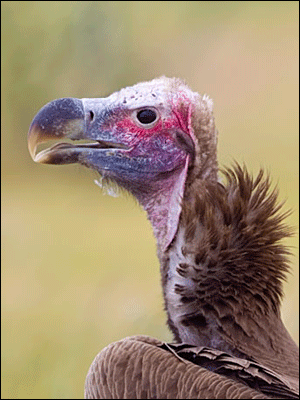 |
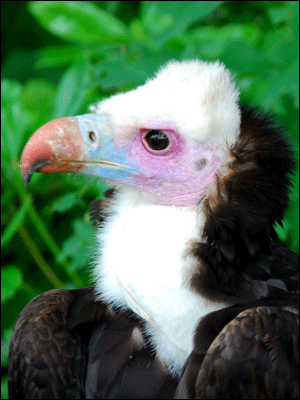 |
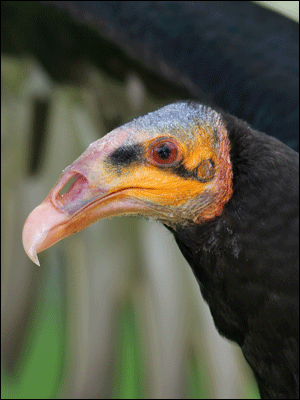 |
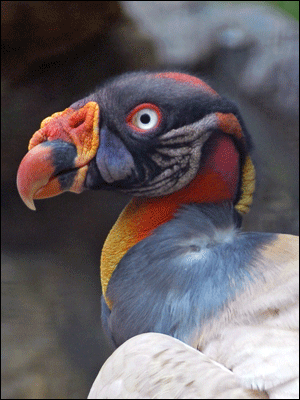 |
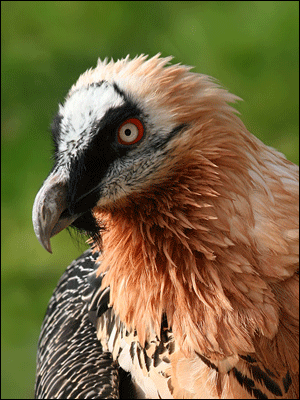 |
| Mike's Contribution: "The Bearded Vulture is the best! And not only are bald heads attractive, but those with beards may hold the secrets to fighting antibiotic-resistant infections!!" Click here for details. | ||
For those of you who aren’t immediately attracted to a baldy, sunburnt-red head, you might still be interested to learn that, as scavengers of carrion, the 23 species of vultures around the World perform an outstanding ecological service for humans. By rapidly and efficiently consuming carcasses, particularly dead livestock, vultures clean the environment and help protect humans, livestock, and wildlife from infectious diseases. If an animal dies from e.g. botulism (a bacterium which can also kill humans), vultures can feast on the carcass without any problems: their stomach acid is at least 10 times that of humans, so a vulture’s gut destroys huge amounts of potentially pathogenic bacteria. In another "don’t read immediately after lunch" study by Gary Graves and colleages at Aarhus University in Denmark, they discovered that Turkey and Black Vultures can have on their heads an average of 528 different types of bacteria (incl. those which cause botulism, gangrene, and tetanus), but about 85% of these pathogens are eliminated by the time everything was digested – vulture poo is astonishingly clean! Most important, the infectious carcasses on which they dined were removed from the environment, preventing other hungry animals from becoming either a victim or vector for whatever killed the first animal. Very useful, indeed!
What Happens When Vultures Die-Off?
Unfortunately, the tragedy of losing this extraordinary ecological service has been felt in South Asia for several decades as vulture populations collapsed by 97- 99.9% from the late 1990s onwards. The decline was caused in large part by a non-steroidal anti-inflammatory drug (NSAID) called diclofenac, which was used commonly to treat livestock for conditions ranging from pnuemonia to arthritis. Unfortunately, Old World vultures in the genus Gyps (family Accipitridae) are extremely sensitive to this compound: when they feed on the carcasses of animals recently-medicated with diclofenac, vultures suffer renal failure and die.
The consequence in South Asia was that, as vulture populations declined precipitously, other disease-carrying mammals came to feed on the carcasses and the populations of these mammals increased accordingly. Mostly notably in India was an increase in the number of dogs, which replaced vultures as the main scavenger at carcass dumps. The increase in dogs led to an increase in the prevalence of rabies, which led to an increase in people dying from rabies after being bitten by infectious dogs. In a groundbreaking paper, Anil Markandya and colleagues estimated that, with the decline of 10 million vultures between 1992 and 2003, food from carcasses became available to support the estimated 7.25 million increase in dog numbers in India. They calculated that this resulted in over 38.5 million additional dog bites and more than 47,300 extra deaths from rabies. They also estimated the the increased number of dog bites and rabies victims may have cost the Indian economy USD 34 billion.
Fortunately for vultures and people, the governments of India, Pakistan and Nepal introduced a ban on the manufacture of diclofenac in 2006. Recent surveys suggest vulture numbers have stabilized, but numbers remain very low and recovery will be slow owing to the low annual reproductive output of these long-lived birds.

|
Other NSAIDs found to be harmful to Old World vultures include:
The NSAID Meloxicam thus far has not been reported to cause mortality and is considered to be safe for Old World vultures.
Fortunately for our yardie "John Crows" and, indeed all Turkey Vultures doing their eco-important work across Jamaica, diclofenac has been shown to be tolerated by this species during controlled studies by Dr. Barnett Rattner and his colleagues in South Carolina, USA. This New World vulture species (Cathartes aura) belongs to a different taxonomic family (Cathartidae) from Old World vultures and, as Dr. Rattner and his colleagues note, differential sensitivity among avian species is a hallmark of NSAID drugs which are "cyclooxygenase-2 inhibitors".
As further reassuring news, Jamaican veterinarians report that diclofenac, while available, is not administered to livestock: definitely additional good news for our Turkey Vultures.
Livestock owners in Jamaica, of course, should always be cautious in administering any prescription or non-prescription medication: owners must always follow dosage instructions and when a recently-medicated animal dies, ALWAYS dispose of it properly so Turkey Vultures or other scavengers can’t feed on the remains, just in case the medication proves to be harmful to scavengers.
And drone operators – be aware that your UAV has the capacity to alter the behaviour of wildlife. We’re going to look for funding to see if we can study this more systematically and carefully – we definitely don’t want to significantly disturb our yardie vultures.
In small ways, we all can assist in keeping these often-maligned, misunderstood, unsung eco-heroes soaring.
Useful References
Cuthbert, R., J. Parry-Jones, R.E. Green, and D.J. Pain. 2007. NASAIDs and scavenging birds: potential impacts beyond Asia's critically endangered vultures. Biology Letters 3: 90-93. http://rsbl.royalsocietypublishing.org/content/3/1/91
Supplementary Information: Meloxicam results
Cuthbert, R., M.A. Taggart, V. Prakash, M. Saini, D. Swarup, S. Upreti, R. Mateo, S.S. Chakraborty, P. Deori, R.E. Green. 2011. Effectiveness of action in India to reduct exposure of Gyps vultures to the toxic veterinary drug diclofenac. PLoS ONE 6(5): e19069. doi:10.1371/journal.pone.0019069
Lisney, T.J., K. Stecyk, J. Kolominsky, G.R. Graves, D.R. Wylie, and A.N. Iwaniuk. 2013. Comparison of eye morphology and retinal topography in two species of New World vultures (Aves: Cathartidae). The Anatomical Record 296: 1954-1970. http://onlinelibrary.wiley.com/doi/10.1002/ar.22815/full
Mallon, J., K.L. Bildstein, and T.E. Katzner. 2015. In-flight turbulence benefits soaring birds. Auk 133: 79-85. http://www.bioone.org/doi/full/10.1642/AUK-15-114.1
Markandya, A., Taylor, T., Long, A., Murty, M. N., Murty, S. and K. Dhavala. 2008. Counting the cost of vulture decline—An appraisal of the human health and other benefits of vultures in India. Ecological Economics 67: 194–204.
Oaks, J.L., M. Gilbert, M. Z. Virani, R.T. Watson, C.U. Meteyer, B.A. Rideout, H.L. Shivaprasad, S. Ahmed, M.J.I. Chaudhry, M. Arshad, S. Mahmood, A. All, and A.A. Khan. 2004. Diclofenac residues as the cause of vulture population decline in Pakistan. Nature 427: 630-633.
Prakash, V., M.C. Biswakarma, A. Chaudhary, R.J. Cuthbert, R. Dave, M. Kulkarni, S. Kumar, K. Paudel, S. Ranade, R. Shringarpure and R.E. Green. 2012. The population decline of Gyps vultures in India and Nepal has slowed since veterinary use of diclofenac was banned. PLoS ONE 7(11): e49118. doi:10.1371/journal.pone.0049118.
Rattner, B.A., M.A. Whitehead, G. Gasper, C.U. Meteyer, W.A. Link, M.A. Taggart, A.A. Meharg, O.H. Pattee, and D.J. Pain. 2008. Apparent tolerance of Turkey Vultures (Cathartes aura) to the non-steroidal anti-inflammatory drug diclofenac. Environmental Toxicology and Chemistry 27: 2341–2345.
Roggenbuck, M., I.B. Schnell, N. Blom, J. Bælum, M.F. Bertelsen, T.S. Pontén, S.J. Sørensen, M.T.P. Gilbert, G.R. Graves, and L.H. Hansen. 2014. The microbiome of New World vultures. Nature Communications 5:5498 doi: 10.1038/ncomms6498.
Smith, S.A. and R.A. Paselk. 1986. Olfactory sensitivity of the Turkey Vulture (Cathartes aura) to three carrion-associated odorants. Auk 103:586-592.
Tyson, P. 2014. Dogs' dazzling sense of smell. Posted 10.04.12 on NOVA scienceNoW website.
| PREVIOUS CHARACTER |

